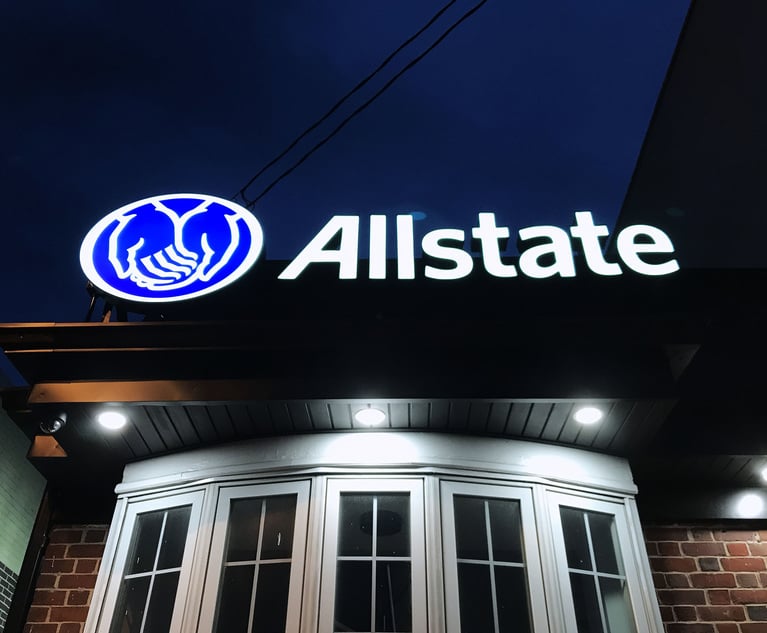'Lawson v. GrubHub': Good Omen or Temporary Reprieve?
A California federal district court may have just provided some breathing room for companies that pay for services from independent contractors.
February 21, 2018 at 01:45 PM
6 minute read
 Gina M. Roccanova of Meyers Nave Riback Silver & Wilson.
Gina M. Roccanova of Meyers Nave Riback Silver & Wilson.
A California federal district court may have just provided some breathing room for companies that pay for services from independent contractors. May have—because although the Feb. 8 decision in Lawson v. GrubHub provides some helpful language and guidance in this area, the California Supreme Court will soon have the final word on this topic.
Although the law is still in flux on the difference between employees and independent contractors, Magistrate Judge Jacqueline Scott Corley's thoughtful decision in the GrubHub case is remarkable for two reasons: the case came out in favor of the purported employer; and it provides some helpful guidance for companies that use contract labor. That guidance, albeit both temporary and based on a fairly extreme set of facts, is valuable, because this area has been a minefield.
As in any minefield, the stakes are high. According to a 2016 McKinsey Global Institute study, between 54 and 68 million people work as independent contractors in the United States, a number that continues to grow as the gig economy expands. A significant number of companies depend on independent contractors for their business models to work. A July 2015 article in the technology journal Recode estimated that Uber—one of the marquee players in the gig economy—would have to pay an additional $209 million annually in California alone if it were to reclassify its independent contractors as employees. And that calculation is based only on payroll taxes and workers' compensation premiums. It doesn't take into consideration other employment-related expenses such as mandatory sick pay or expense reimbursements. It is likely that some companies in this sector would not survive having to reclassify all of their contractors if such a requirement were forced on them.
Even companies whose business models do not depend to the same degree on independent contractors bear significant risk. The legal liability for misclassifying employees as independent contractors can be enormous. In addition to unpaid payroll taxes and associated penalties, employers may be liable to misclassified employees for injuries that would otherwise be covered by workers' compensation, unpaid overtime, missed meal and rest break penalties, penalties for inaccurate record keeping and wage statements, fines of up to $25,000 per violation, waiting time penalties, and attorneys' fees, not to mention their own hefty legal costs. Class action and Private Attorney General Act settlements in the millions of dollars appear routinely in the legal news, and in 2016, FedEx paid $227 million to settle a federal misclassification class action suit with drivers in 19 states.
The terrain is also uncertain. California law begins with a presumption that anyone who performs services for compensation is an employee. Under the test set forth by the California Supreme Court in S.G. Borello & Sons v. Department of Industrial Relations (1989) 48 Cal.3d 341, a purported employer who wishes to prove otherwise must convince the court that the contractor retains control over the “manner and means” by which the contracted-for service is performed. In making this determination, courts consider whether the relationship bears the hallmarks of employment, such as set work hours, work rules, performance evaluations, and the ability of the parties to terminate the relationship at will. In addition to the primary question of control, courts must also consider numerous secondary factors, including:
- Whether the contractor is engaged in a business distinct from that of the principal;
- The degree to which the service provided is a part of the principal's business (e.g., someone providing delivery services for a delivery business, versus someone providing accounting services for a delivery business)
- Whether the nature of the work is such that it is ordinarily performed without supervision;
- Whether the contractor uses his or her own tools, equipment, and space to perform the work;
- The degree of skill required;
- The length of the engagement;
- Whether the work is paid by the job or by the time spent; and
- The intentions of the parties.
Applying the Borello factors, Magistrate Judge Corley concluded that the delivery driver plaintiff in the GrubHub suit was not an employee. In reaching this conclusion, she placed particular weight on GrubHub's almost total lack of oversight over its delivery contractors. The company exerted little or no control over its contractors' modes of transportation, their attire, vehicle signage, schedules, number of deliveries, the amount of time taken to complete deliveries or the tone or quality of their interactions with customers. GrubHub's hands-off approach was so complete it allowed the plaintiff to game the system, sometimes taking over an hour to make deliveries and claiming pay for scheduled blocks he did not work. Magistrate Judge Corley did find that the right to terminate the relationship at will weighed significantly in favor of an employment relationship, and concluded that some of the secondary Borello factors did as well, such as the degree of skill involved, the fact that delivering meals was part of—albeit not critical to —GrubHub's business, the plaintiff's lack of a distinct occupation or business, and the method of payment. However, on balance, given the lack of “necessary” control, the facts supported an independent contractor relationship.
The distinction between independent contractors and employees in California may soon change dramatically. The California Supreme Court recently heard argument on whether a simpler but considerably more strict standard should apply. In Dynamex Operations West v. Superior Court, the appellate court relied on the definition of “employer” contained in the Industrial Welfare Commission Wage Orders—“any person … who directly or indirectly, or through an agent or any other person, employs or exercises control over the wages, hours, or working conditions of any person.” (Cal. Code Regs., tit. 8, Section 11090, subd. 2(F).) The court cited Martinez v. Combs (2010) 49 Cal.4th 35, 64—a dispute over who could be held liable for wages—for a definition of employment that bring many, even most of the common law independent contractor relationships under the definition of employment: “To employ, then, under the IWC's definition, has three alternative definitions. It means: to exercise control over the wages, hours or working conditions, or to suffer or permit to work, or to engage, thereby creating a common law employment relationship.”
If the California Supreme Court adopts the Wage Order definition of employment in this context, there will be significant impacts both in the gig economy and elsewhere. In an ideal world, the court—or the legislature—would fashion a test that reflects the realities of the modern workplace. In the meanwhile, though, companies that use contract labor may want to keep a copy of the GrubHub decision handy.
Gina Roccanova is a principal at Meyers Nave Riback Silver & Wilson and chair of the labor and employment practice group, where she serves public and private clients with nearly 20 years of experience in negotiations, counseling, litigation, arbitration and training.
This content has been archived. It is available through our partners, LexisNexis® and Bloomberg Law.
To view this content, please continue to their sites.
Not a Lexis Subscriber?
Subscribe Now
Not a Bloomberg Law Subscriber?
Subscribe Now
NOT FOR REPRINT
© 2025 ALM Global, LLC, All Rights Reserved. Request academic re-use from www.copyright.com. All other uses, submit a request to [email protected]. For more information visit Asset & Logo Licensing.
You Might Like
View All
State Appeals Court Revives BraunHagey Lawsuit Alleging $4.2M Unlawful Wire to China
3 minute read

Apple Disputes 'Efforts to Manufacture' Imaging Sensor Claims Against iPhone 15 Technology

Lawsuit alleges racial and gender discrimination led to an Air Force contractor's death at California airfield
7 minute readTrending Stories
- 1We the People?
- 2New York-Based Skadden Team Joins White & Case Group in Mexico City for Citigroup Demerger
- 3No Two Wildfires Alike: Lawyers Take Different Legal Strategies in California
- 4Poop-Themed Dog Toy OK as Parody, but Still Tarnished Jack Daniel’s Brand, Court Says
- 5Meet the New President of NY's Association of Trial Court Jurists
Who Got The Work
J. Brugh Lower of Gibbons has entered an appearance for industrial equipment supplier Devco Corporation in a pending trademark infringement lawsuit. The suit, accusing the defendant of selling knock-off Graco products, was filed Dec. 18 in New Jersey District Court by Rivkin Radler on behalf of Graco Inc. and Graco Minnesota. The case, assigned to U.S. District Judge Zahid N. Quraishi, is 3:24-cv-11294, Graco Inc. et al v. Devco Corporation.
Who Got The Work
Rebecca Maller-Stein and Kent A. Yalowitz of Arnold & Porter Kaye Scholer have entered their appearances for Hanaco Venture Capital and its executives, Lior Prosor and David Frankel, in a pending securities lawsuit. The action, filed on Dec. 24 in New York Southern District Court by Zell, Aron & Co. on behalf of Goldeneye Advisors, accuses the defendants of negligently and fraudulently managing the plaintiff's $1 million investment. The case, assigned to U.S. District Judge Vernon S. Broderick, is 1:24-cv-09918, Goldeneye Advisors, LLC v. Hanaco Venture Capital, Ltd. et al.
Who Got The Work
Attorneys from A&O Shearman has stepped in as defense counsel for Toronto-Dominion Bank and other defendants in a pending securities class action. The suit, filed Dec. 11 in New York Southern District Court by Bleichmar Fonti & Auld, accuses the defendants of concealing the bank's 'pervasive' deficiencies in regards to its compliance with the Bank Secrecy Act and the quality of its anti-money laundering controls. The case, assigned to U.S. District Judge Arun Subramanian, is 1:24-cv-09445, Gonzalez v. The Toronto-Dominion Bank et al.
Who Got The Work
Crown Castle International, a Pennsylvania company providing shared communications infrastructure, has turned to Luke D. Wolf of Gordon Rees Scully Mansukhani to fend off a pending breach-of-contract lawsuit. The court action, filed Nov. 25 in Michigan Eastern District Court by Hooper Hathaway PC on behalf of The Town Residences LLC, accuses Crown Castle of failing to transfer approximately $30,000 in utility payments from T-Mobile in breach of a roof-top lease and assignment agreement. The case, assigned to U.S. District Judge Susan K. Declercq, is 2:24-cv-13131, The Town Residences LLC v. T-Mobile US, Inc. et al.
Who Got The Work
Wilfred P. Coronato and Daniel M. Schwartz of McCarter & English have stepped in as defense counsel to Electrolux Home Products Inc. in a pending product liability lawsuit. The court action, filed Nov. 26 in New York Eastern District Court by Poulos Lopiccolo PC and Nagel Rice LLP on behalf of David Stern, alleges that the defendant's refrigerators’ drawers and shelving repeatedly break and fall apart within months after purchase. The case, assigned to U.S. District Judge Joan M. Azrack, is 2:24-cv-08204, Stern v. Electrolux Home Products, Inc.
Featured Firms
Law Offices of Gary Martin Hays & Associates, P.C.
(470) 294-1674
Law Offices of Mark E. Salomone
(857) 444-6468
Smith & Hassler
(713) 739-1250






